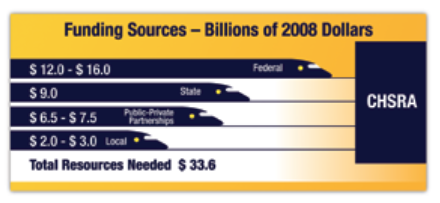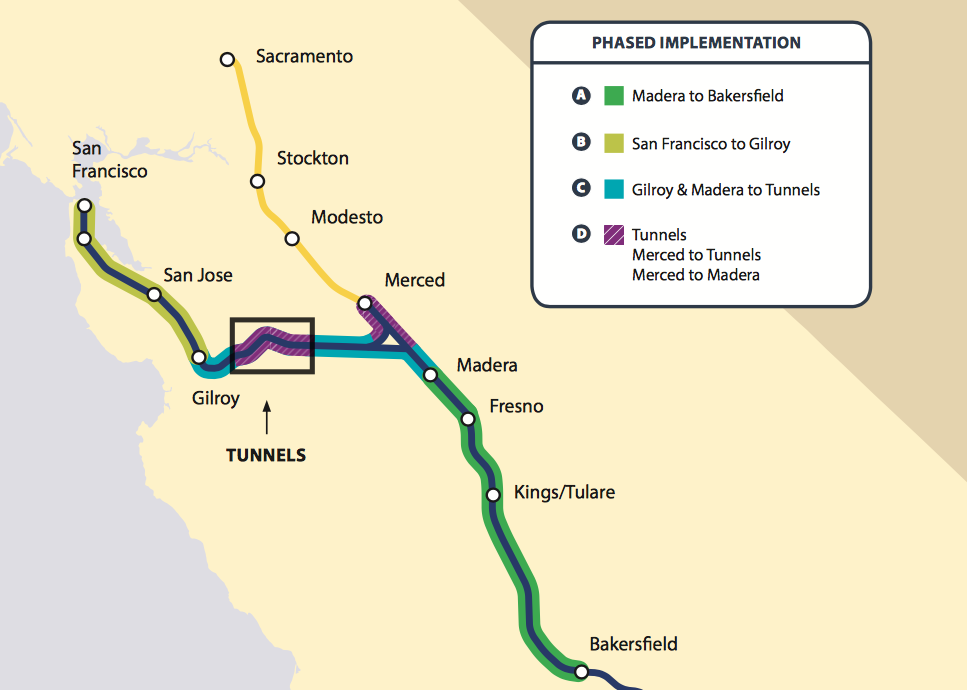March 14, 2018
[CHSRA = California High Speed Rail Authority. Hyperlinks are to CHSRA business plans and funding plans unless otherwise noted.]
November 1999 – A funding plan commissioned by CHSRA and later incorporated into its 2000 business plan estimates the cost of a 670-mile HSR system (San Francisco through Los Angeles to Irvine, including extensions to Sacramento and San Diego) to be $25 billion in 1999 dollars.
August 2005 – An initial environmental impact report prepared by CHSRA in cooperation with the Federal Railroad Administration finds that the cost of the 670-mile plan described in 1999 would “range between $33 billion and $37 billion (2003 dollars), depending on the alignment and station options selected.”
Sometime in 2006 – CHSRA increases the cost estimate for the entire system, including the Sacramento and San Diego extensions, to $45 billion. (We can’t find this on the CHSRA website but the nonpartisan California Legislative Analyst’s Office quoted this 2006 estimate in the 2008 Prop 1A voter guide.)
November 2008 – A new business plan focuses just on the 520-mile San Francisco to Anaheim segment, now called Phase 1, with the Sacramento and San Diego extensions (Phase 2) postponed indefinitely. The plan promises voters that $9 billion in Proposition 1A bonds would be coupled with $2-3 billion in local funding, $12-16 billion in federal funding, and $6.7-$7.5 billion in public-private partnership funding, which would be enough to build a complete San Francisco to Anaheim system costing $33.6 billion in 2008 dollars. Voters then approved Prop 1A, 52.6% to 47.4%.

However, this presentation had an inherent flaw – while the costs were presented in constant 2008 dollars that would inflate with time, the state’s $9 billion bond contribution was a fixed amount that would not inflate with time. $9 billion in bonds was 27 percent of $33.6 billion, but as the 2008 dollars inflate over time, a fixed $9 billion in bonds would inevitably shrink as a percentage of total cost.
December 2009 – CHSRA updates the $33.6 billion cost estimate (which was in 2008 dollars) to $34.9 billion (also in 2008 dollars), and then converts that to $42.6 billion in year-of-expenditure (YOE) dollars. The revised business plan assumes $9 billion in Prop 1A bonds, $17-19 billion in federal funds, $4-5 billion in local funding, and $10-12 billion in public-private partnerships.
November 2011 – The draft 2012 business plan has a massive increase in the cost estimate for Phase 1, now projected to cost between $65.4 billion and $74.5 billion. A separate finance plan puts the cost of the Central Valley segment at $6.0 billion and offers two alternatives for an Initial Operating Section (IOS): one that goes from Bakersfield north to San Jose, costing an additional $24.7 billion, and the other from Merced south to the San Fernando Valley, costing an additional $27.2 billion. (All in YOE dollars.)
April 2012 – A revised 2012 business plan calls for the IOS to go from Merced to the San Fernando Valley and also calls for slowing down high-speed service as the eventual endpoints approach San Francisco and Los Angeles, “blending” the high-speed trainsets and low-speed commuter rails on the same tracks to save money. The cost of Phase 1 with the “blended” slowdown at both ends has ballooned to $68.4 billion in YOE dollars. (A “full build” of high-speed lines through to downtown Anaheim and San Francisco would add another $23 billion to the cost.) The plan assumes $41.9 billion in federal funding, $8.2 billion from the state Prop 1A bonds, $13.1 billion in private funding, and $5.2 billion in other funding.
April 2014 – A revised business plan takes the cost of Phase 1 down slightly to $67.6 billion in YOE dollars (mostly by cutting real HSR service short of Anaheim and making Anaheim-bound passengers switch trains to Metrolink) with a 2028 completion date. It still has no solid plan for finding the money.
May 2016 – The revised business plan reverses course (literally) and decides that the IOS will go north from the Central Valley, not south, and won’t start service until 2025, not 2022 as promised in the earlier plan. The estimate cost of Phase 1 in YOE dollars drops again, to $64.2 billion and restores the promise of single-seat high-speed service to Anaheim. The plan suggests using cap-and-trade revenues and bonds based thereon to get enough funding to complete HSR service from San Jose to just north of Bakersfield in the IOS but has no solid suggestions for funding the rest of Phase 1.
March 2018 – The draft of the latest business plan begins giving a range of estimated costs, not a single number. Total cost of Phase 1 is now expected to range from $63.3 billion to $98.1 billion, with CHSRA suggesting a middle case of $77.3 billion. The plan also admits that even with bonds based on cap-and-trade revenues (if authorized and guaranteed by the state legislature), their existing funding won’t be enough to finish the first IOS, so the plan suggests completing and operating service on two non-connected segments, one from San Francisco to Gilroy and another from Merced to Bakersfield, in hopes that another $5-10 billion will become available from other sources later on to pay for the 41-mile missing link (which includes digging 15 miles of tunnels through the Pacheco Pass) to connect Gilroy to Madera and Merced.






